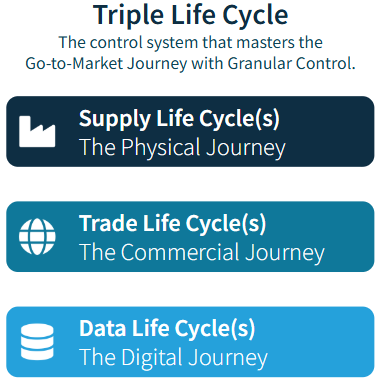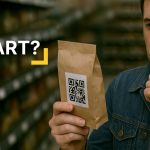
The Architectural Secret Behind Digital Clarity in Packaged Goods
SyncForce Circular PIM is the only PIM built specifically for the Packaged Goods Industry, where the Sales Unit is defined as Product + Packaging.
This simple but fundamental distinction enables packaged goods companies to manage data, compliance, and sustainability with precision that mainstream PIM/PXM solutions such as Akeneo, Salsify or PIMcore were never designed to support.
But in the world of packaged goods, that approach no longer holds.
The End of the “Golden Record” Era
With the growing focus on healthier and more sustainable products, new regulations such as the ESPR (for products) and PPWR (for packaging) make it essential to distinguish what we consume or use from what contains and protects it.
In packaged goods, these are two separate but connected entities, the Product and its Packaging. Together, they form what the customer actually buys, the Sales Unit.
This is the Keystone Principle.

Why the Split Matters
A product is what the consumer eats, drinks, uses or operates. Packaging is what contains, protects and presents that product. Both are governed by different design rules, safety obligations and sustainability requirements.
Consider a bottle of beer.
- The Product is the beer itself.
- The Packaging consists of a bottle, three labels and a crown cork, each with its own material composition, origin and recyclability profile.
Or take a bag of Mars Celebrations: one Sales Unit containing multiple Products (Snickers, Mars, Milky Way), each with its own nutrient and allergen information.
Without separating product and packaging, it becomes impossible to know whether a substance belongs in the ingredient list or the packaging materials table. Data duplication, incomplete reporting and compliance gaps are inevitable.
Only when both are modelled as distinct but connected entities can companies manage complexity, comply with regulation and maintain digital accuracy.
The Ripple Effect of Change
When product and packaging data are stored together, a single update can cause a chain reaction.
Imagine a PET bottle upgraded from 0% to 37% post-consumer recycled content. That single improvement can affect more than a hundred Sales Units.
In mainstream PIMs, this requires updating each Sales Unit manually.
In SyncForce Circular PIM, the bottle is a shared Packaging Element linked to all relevant Sales Units. Updating it once synchronises every instance automatically, eliminating side spreadsheets, reducing errors and keeping sustainability data consistent.

The Sales Unit as the Keystone
The Sales Unit is the commercial reality, the item customers and retailers buy. It connects the Product (consumable, durable or disposable) and the Packaging (sales, grouped or transport) into one complete commercial object.
In the Golden Hierarchy, the Sales Unit functions as the keystone, locking Product and Packaging together and anchoring both within the three independent but connected life cycles that form the SyncForce Operating System for Bringing Packaged Goods to Market:
- Supply Life Cycle – the physical journey of the unit
- Trade Life Cycle – its commercial availability per market or channel
- Data Life Cycle – its digital journey across systems and channels
Remove the keystone, and the structure collapses. With the keystone in place, data remains stable and synchronised across all departments and systems.

GTINs, QR Codes and the Digital Twin
GS1 defines the GTIN at the Sales Unit level, the actual object that is bought or sold. The upcoming GS1 Digital Link and Commercial Production Variant (CPV) build on this principle, enabling digital twins that reflect the latest real-world variant of a product or pack.
This allows manufacturers and retailers to display live, accurate information, showing, for example, a new “more sustainable packaging” story or an updated “improved recipe”.
Without the Keystone Principle, the link between physical and digital reality breaks down, and maintaining trustworthy product data becomes impossible.
Compliance by Design
The Keystone Principle is also the structural foundation for regulatory compliance.
Each part of the Sales Unit carries its own declaration and obligations:
- Product (ESPR, CLP, Food/Feed Regulations) – requires a Declaration of Conformity (DoC) confirming compliance with safety, composition and performance requirements.
- Packaging (PPWR) – also requires a Declaration of Conformity (DoC) confirming that the Unit of Packaging meets design, composition, recyclability and labelling requirements. This includes every component of the Sales Packaging, such as the bottle, cap, labels, foil or tray, and must be supported by technical documentation and conformity evidence.
In practice:
- The Product DoC proves that what is inside the pack complies with ESPR or other relevant legislation.
- The Packaging DoC proves that what surrounds it complies with PPWR.
The Sales Unit is where these two declarations meet, ensuring the full item placed on the market is compliant as a whole.
No Workarounds, No Data Chaos
Mainstream PIM systems, built for retail, treat everything as a single “product”. In packaged goods, this leads to endless duplication, retyping the same packaging data for every commercial variant: 3-pack, 5-pack, hanging blister, counter display or pallet.
The result is side spreadsheets, inconsistent data and regulatory risk.
In SyncForce Circular PIM, the Sales Unit locks Product and Packaging into a single, stable structure. Update a bottle or a label once, and every connected Sales Unit inherits the change automatically.
Outcomes:
- No workarounds
- No duplicate entry
- Consistent, validated data across every system and channel
The Foundation for the Future
In architecture, the keystone is the small stone that locks the arch together. Remove it, and the structure falls apart.
In packaged goods, the Sales Unit is that keystone. It binds Product and Packaging into one coherent entity, ready for the digital twin, compliant with ESPR and PPWR, and future-proof for GS1 Digital Link and the EU Digital Product Passport.
The Keystone Principle is where the Operating System for Bringing Packaged Goods to Market begins.
In Summary
Industry: Packaged Goods (Food, Pet Food, Home & Personal Care)
Use Case: Managing and distributing accurate product and packaging data across multiple markets and channels
Core Principle: The Sales Unit = Product + Packaging
Why It Matters: Ensures compliance with ESPR and PPWR, eliminates duplication and synchronises digital twins with physical reality
Outcome: A stable, compliant and scalable data foundation for the entire go-to-market chain


